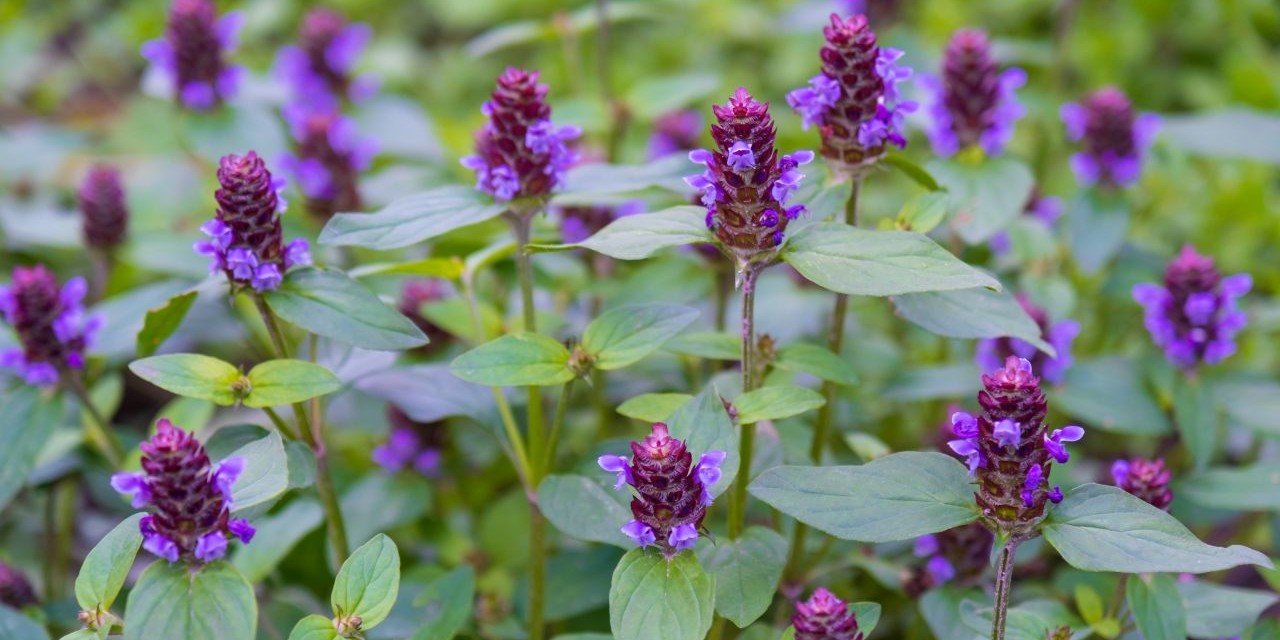
Self-Heal Plant
Self-heal (Prunella vulgaris) is an edible flowering plant that is useful for treating many illnesses. For many centuries, the Prunella vulgaris exists as an important herb and elixir in folk medicines. Sometimes called the ‘heart of the earth’ for its revered status in traditional herbalism, the Self-heal plant has many names like Hercules, dragonhead, woundwort, wound root, carpenter’s herb, or heal-all, among others.
The History of Prunella vulgaris
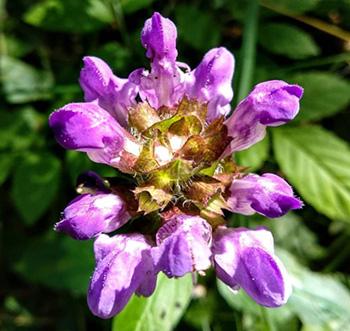
Prunella vulgaris, a member of the genus Prunella, grows in abundance in many geographical locations across the world. Botanists traced its origin in Eurasia and America. During 1800, the plant spread into many countries across the Pacific Islands and New Zealand. There are several species within the genus Prunella, but Prunella vulgaris is the most widely used.
Traditionally, people cultivate this herb mostly for its medicinal value. Its leaves are useful for promoting wound healing. It is also a traditional cure for throat and mouth infections, including sore throats, and an effective treatment for Ascaris infections. Its compound and properties may also alleviate symptoms of many other ailments.
During the 16th century, herbalist John Gerard regarded that there is no a better wound herb than Prunella vulgaris. Botanist Nicholas Culpeper later called the plant the Self-heal plant in the 17th century. With its ability in curing sore throat, it earned its name Prunella from Brunella or Die Braune. It is the German term for quinsy, a type of throat inflammation.
Self-heal is not only beneficial in treating illnesses. It is also a good addition to salads and other recipes. Today, this plant can be consumed as a pill or liquid extract. Sometimes, it is also used as an ingredient in ointments and balms.
With its healing abilities, scientists are continuing to study the efficacy of the plant against life-threatening diseases. These studies analyze its effect in preventing cancer, and atherosclerosis or the hardening of the arteries. It also gears into its potency in treating diabetes and its complications.
Where Is This Plant Found?
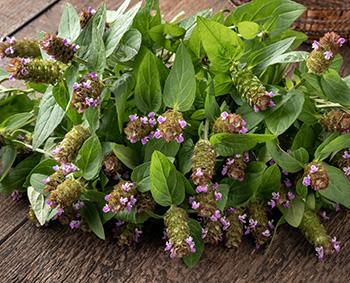
Prunella vulgaris is a wildflower that grows in many continents across the world and fares better in most temperate climates. This is a native perennial herb in Europe, Asia, North America, and the tropical mountains of Africa.
It is also abundant in Pacific Islands, especially in New Zealand and Australia. The herb can also be found in Hawaii and Ireland.
The plant survives in basic and neutral soils with enough moisture and sunlight. Thus, it proliferates in meadows, grassland, lawn, woodland edges, roadsides, and rough grounds. Prunella vulgaris spreads through a root system of slender rhizomes and can become quite weedy and invasive under certain conditions. Its growth and spread can also be influenced by other conditions such as soil type and moisture. That is why it is more beneficial as a ground cover than as a garden plant.
Related: The Complete Map of Edible Plants: Find Out What You Have in Your Area! (Video)
How to Identify Prunella vulgaris
The Self-heal plant is abundant in temperate climates with basic soil. The plant’s foliage usually grows up to a height of 6 inches or higher. But it will produce blossoms that reach up to 8 inches during its blooming stage. The stems of Prunella vulgaris have a square stem and are often reddish, especially in young stems. You will notice reddish stems branching at the leaf nodes. These stems are self rooting when they touch the ground, allowing the species to spread easily. When mowed regularly, the plant can become densely matted and small-leaved.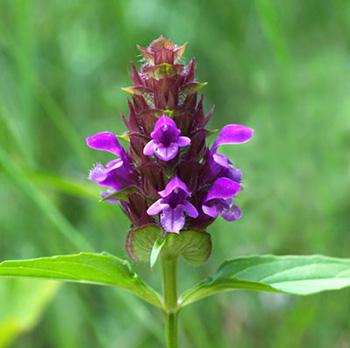
- Flower. Although it is a member of the mint family, Prunella vulgaris does not exude any fragrance common to mint. The flowers bloom in the summertime and are either white or purple-blue. The flowers grow out of a conical terminal spike that elongates during the budding stage, forming a distinctive whirled cluster at the top of the stem. The flowers are two-lipped with a tubular shape. The top lip forms a purple hood, while the lower part is the bottom lip, which has three lobes. The middle lobe is larger and often fringed upwardly. The lower lobes are mostly white or a slightly lighter shade than the top. The shape of the Self-heal flowers resembles a mouth.

- Leaf. Prunella vulgaris leaves are sparse and include stalkless leaves that grow in opposite pairs by the stem. Some stalkless leaves standing directly on the stem form a collar-like appearance below the whirled cluster of flowers. The leaves also have fine hairs on the underside of each leaf. Self-heal has two different types of leaves: the basal leaf and the stem leaf. The basal leaves, or those found in the lower stem, are ovate and with broad and rounded tips. The leaves on its stem are lance shaped, oblong with a blunt tip, and grow on nodes along the stem in pairs.
- Root. The roots of Self-heal are fibrous with short rhizomes or root crowns. They are also shallow that shoots out from the stem node.
- Prunella vulgaris stems are erect and branching with a square shape and covered with fine hairs. The young stems are reddish and hairy, shedding as the plant matures. The stems of Prunella vulgaris easily self-root when they touch the ground.
- Fruit and Seeds. Self-heal produces a dry fruit pod with four brownish-yellow seeds contained in a calyx. These seeds are pear-shaped with two slightly flattened sides and around the third side. When the fruit is ripe, it will drop the seeds out of the calyx to reproduce.
Related: The Best Guide to Identify over 400 Wild Plants (Video)
How to Grow Prunella vulgaris
The Self-heal plant is easy to propagate through its seed and its creeping roots. It is also adaptable to its environment, and thus, simple to grow and care for. The plant grows best in an environment with cool to mild temperatures. It also requires the sun and a partial shade.
Spring is the best time of the year to sow Prunella vulgaris seeds or plant its stolon or root division. Seeds are sown in early spring, allowing the plant to establish well. You can also divide the plant in the fall for propagation. Planting the plant during springtime will allow it to bloom at its fullest during the summer season, but flowers may bloom at different times or at various times depending on environmental conditions.
Briefly, here are the requirements for growing Prunella vulgaris in the best of health:
 Well-draining soil (loamy, sandy, volcanic ash, clay soil) that is kept moist and rich in organic matter
Well-draining soil (loamy, sandy, volcanic ash, clay soil) that is kept moist and rich in organic matter- Full sun or partial shade
- Regular deep watering
- Balanced 10-10-10 NPK fertilizer

If you are growing Prunella vulgaris using seed, you can sow it in the garden after the last frost. You may stratify or chill it in the refrigerator while waiting for the last frost date. Sow the seeds on soil, but do not cover them as they need light for germination. The seeds will grow at an ideal temperature of 70 to 75°F. Transplant the Prunella vulgaris seedlings when they are already large enough to handle.
When re-planting root division, plant it at about 4 to 6 inches deep and 6 to 9 inches apart. Prunella vulgaris will also grow from cuttings. Since the plant spreads through rhizomes, you may need individual containers if planting it as a border plant. Make sure that the pot does not sit flush with the ground to keep the plant from spreading. You can also shear off flower heads once the flower falls off to prevent it from re-seeding.
To create a new patch or garden bed with self heal, use seed, root division, or cuttings to establish healthy growth.
Related: The 10 Medicinal Seeds You Should Plant for a Complete Backyard Pharmacy (Video)
How to Harvest Prunella vulgaris
When harvesting Prunella vulgaris for its medicinal value, the whole plant is often harvested during the mature flowering stage to ensure maximum medicinal benefit. This guarantees that you are able to collect herbs at their maximum potency. All the aerial parts of the Self-heal plant are useful and can be harvested. These are the parts of the plant that do not directly touch the ground.
To harvest properly, do the following steps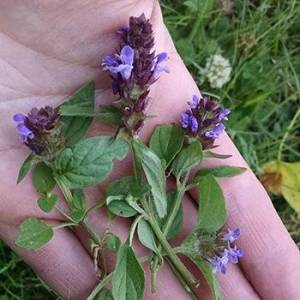
- Trim the stem just above the ground surface and leave the roots if you plan on re-growing it. You may harvest the plant for more than just one season if you leave the root system in place. The best time to harvest Prunella vulgaris is later in the day when the dew has evaporated. It will prevent the plant from rotting out and getting moldy.
- When drying the plant, clump them in small bunches and hang them upside down to dry. Tie them loosely to prevent molding. You can also use a drying tray or screen to spread them out evenly and turn them daily. It is best to keep the herbs in a cool, dry, and dark place until you are ready to use them. Avoid drying them in direct sunlight as it will bleach the harvest and decrease their value.
 Remember not to combine fresh harvest from the dry or partially dry ones. Also, do not dry Prunella vulgaris in the microwave or oven. The secret to keeping their maximum effect is heat and airflow.
Remember not to combine fresh harvest from the dry or partially dry ones. Also, do not dry Prunella vulgaris in the microwave or oven. The secret to keeping their maximum effect is heat and airflow.- When the harvest is completely dry, it will start to crumble. Put the dried-out plants in a cardboard box or paper bag and store them in a dry area. Plastic is not ideal for storing dried herbs as it will risk infecting it with molds.
What Prunella vulgaris is Good for and Natural Remedies Made from It
The Prunella vulgaris is one of the many wildflowers that is used in folk medicines. For centuries, it serves as an effective herb for various ailments. It is a highly effective antiseptic that is beneficial in treating wounds and mouth ulcers. The early spring leaves of the plant are used as mouthwash and gargle.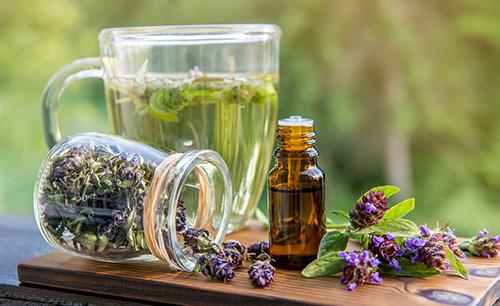
An infusion made from the roots of the Self-heal is used for washing wounds and cuts. It can also stop the blood flow – even internal bleedings – with its highly effective astringent property. A poultice made from the fresh leaves of the plant can relieve bites, scratches, and inflammations. Bathing in boiled leaves of Prunella vulgaris can also relieve muscle pains.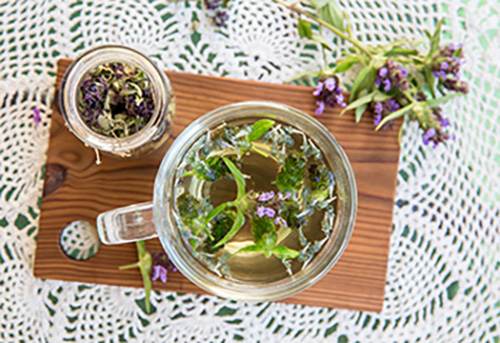
Prunella vulgaris has a bland taste similar to that of romaine lettuce with a slightly bitter or acrid aftertaste. But its raw young leaves and stems are best to go in a salad. To reduce bitterness, you can wash the leaves before eating. Its various plant parts are also a traditional ingredient in soups and stews.
The Self-heal plant has an alterative and anticancer property. Alterative herbs help bring back the balance in the body to boost optimum health. So aside from preventing cancer, diabetes, and other debilitating diseases, it can also promote a healthy metabolism. Calendula and other wildflowers are often combined with self heal in traditional salves and infusions for skin healing.
Related: Similar to Morphine: The Best Natural Painkiller that Grows in Your Backyard (Video)
What Parts of Plants are Used for Remedies?
Everything about the Prunella vulgaris is edible and useful. Its leaves are either cooked, boiled, or eaten raw. Boiled leaves or stems and roots are used for washing cuts and wounds. The chopped, dried, or powdered leaves also make a refreshing beverage when infused in cold water as well as its dried flowers. When making herbal salves or ointments, local beeswax sourced from bees is often used as a base, emphasizing sustainable and ethical harvesting practices.
Self-Heal Tea Recipe
Ingredients:
- 1-2 tsp dried Self-heal
- 1 cup hot water
Steps:
- Put the dried herbs in a tea bag and close properly. If no tea bag is available, you can simply put it directly in a cup.

- Pour hot water over the herbs and steep for 10 minutes. Steeping time will depend on how strong you want your tea to be. Some people who do not like strong tea even steep theirs for only 5 to 7 minutes.

- If using a teabag, you can easily remove the tea bag from the cup after steeping. However, if you have poured water directly over the herbs, simply take out the herb by pouring the liquid through a mesh strainer to another cup.

How to Use:
You can drink about two to three cups of Self-heal tea a day to relieve body pains and ailments. Prunella vulgaris is safe for most people. 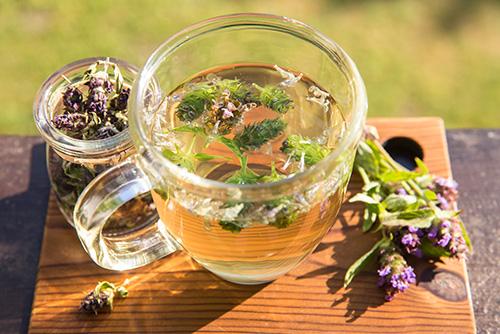 But if your symptoms worsen and you do not get better, you must discontinue using it and consult your doctor immediately.
But if your symptoms worsen and you do not get better, you must discontinue using it and consult your doctor immediately.
Related: All-Purpose First Aid Salve (Learn More)
What Plants Resemble a Prunella Vulgaris?
| Feature | Self-Heal(Prunella vulgaris) | Spotted Deadnettle(Lamium maculatum) | Ground Ivy(Glechoma hederacea) |
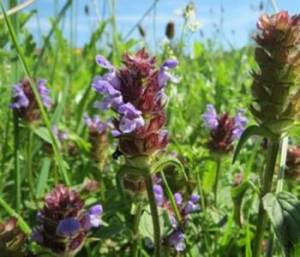 |
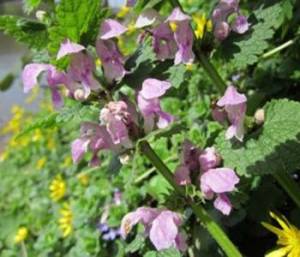 |
 | |
| Size | Height: 2 to 11.8 inWidth: 3 to 19 in | Height: 6 to 12 inWidth: 24 in | Height: up to 36 ftWidth: 36 ft |
| Leaves | Sparse and stalked that grows in opposite pairs by the stem; Self-heal has two different types of leaves: the basal leaf and the stem leaf | Oval or heart-shaped with speckled spots and long petioles with fine hairs | Kidney-shaped bright green leaves |
| Flowers | White or purple-blue flowers; The flowers are two-lipped with a tubular shape | Helmet-shaped upper lip flower in pink or purple; dotted white lower lip | Funnel-shaped violet flowers in whorls of two or four |
| Stem | Stems are erect and branching with a square shape and covered with fine hairs | Hollow-stem branching at the base | Square stems |
| Scent | No noticeable floral or mint scent | An unpleasant scent when bruised | Strong blackcurrant smell |
Warnings and Cautions
The safety of the Self-heal plant in pregnancy and breastfeeding is unknown. To avoid risks, it is best for women in this population to avoid using Prunella vulgaris.
Among the potential side effects of using Self-heal are dizziness, constipation, or weakness, and lethargy.
There is also little information regarding the dosage and other possible side effects of using Self-heal pills or extracts. These herbal supplements are unregulated in the United States. So, when using pharmaceutical Self-heal products, look for third-party testing and certification and follow the recommended dosage.
Before starting any Prunella vulgaris intake, consult your doctor first. Some medications and other underlying medical conditions may interact with this herb.
You may also like:
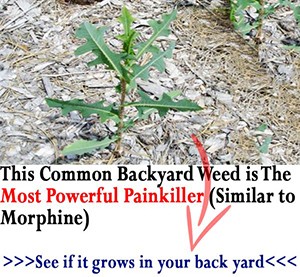 How To Make a Cinnamon Painkilling Tincture
How To Make a Cinnamon Painkilling Tincture
What Happens if You Put Onions in Your Socks Before Sleeping? (Video)
7 Natural Remedies for Fibromyalgia Pain

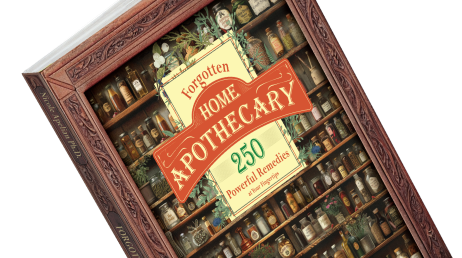







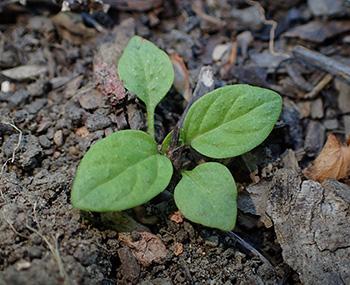 Well-draining soil (loamy, sandy, volcanic ash, clay soil) that is kept moist and rich in organic matter
Well-draining soil (loamy, sandy, volcanic ash, clay soil) that is kept moist and rich in organic matter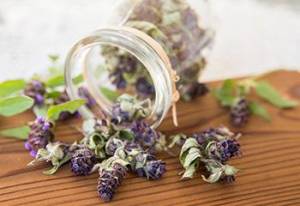 Remember not to combine fresh harvest from the dry or partially dry ones. Also, do not dry Prunella vulgaris in the microwave or oven. The secret to keeping their maximum effect is heat and airflow.
Remember not to combine fresh harvest from the dry or partially dry ones. Also, do not dry Prunella vulgaris in the microwave or oven. The secret to keeping their maximum effect is heat and airflow.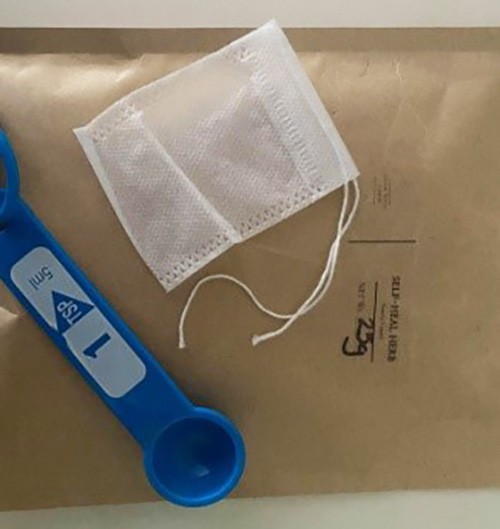

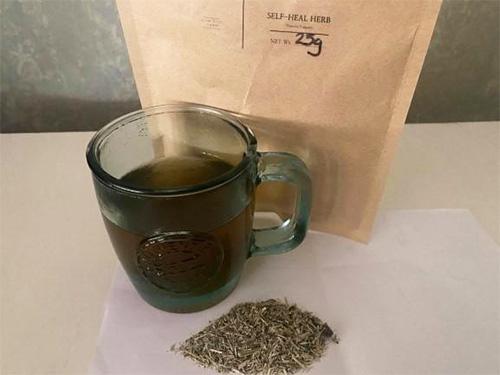
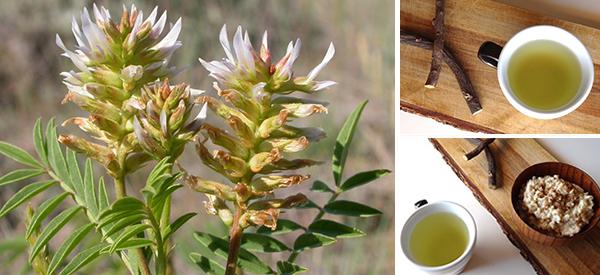
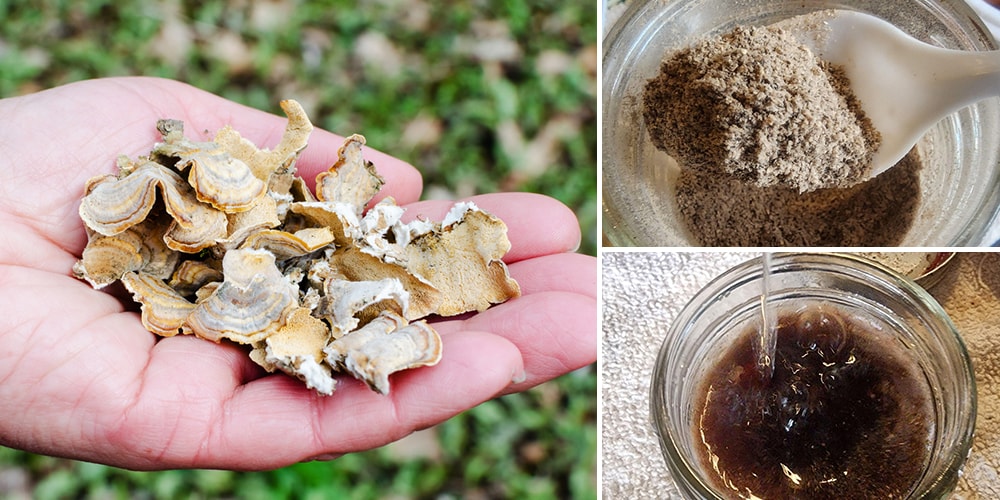
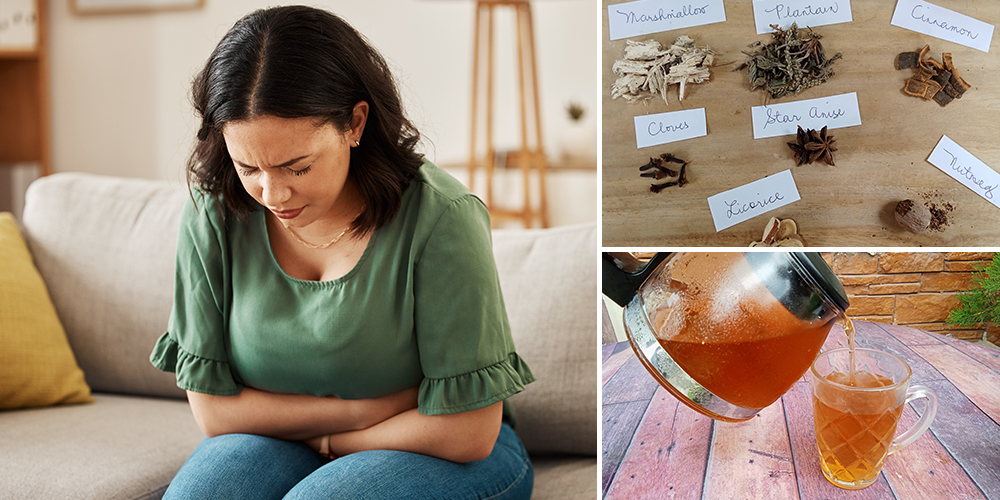
Great information love to get my hands on seeds.
Strictly Medicinal Seed online
Hello Ann Marie, thank you for the article. A line by Nicole about this pointed out how “there is only one [medicinal use] unique in the plant kingdom, that could make Self-heal the most precious herb you’ve ever heard about”. Well, I was expecting part of this article to talk about how Self-heal is one of few plants with immuno-modulatory effects, something more often found in mushrooms. For me this is what makes Self-heal precious!
Thank you for the info Mark. I had to look up immunomodulatory to see what it meant 😁
Where can I buy this plant in terms of Organic ? I have none on my property.
No suggestions about obtaining this plant ?
Hi Karla,
You can find the seeds as well as the dry plant here:
https://mountainroseherbs.com/search.php?search_query=self+heal
I hope this helps.
Many blessings and good health!
You can purchase whole dried self heal (Prunella vulgaris) at https://octoberfields.com/products/organic-self-heal-herb-prunella-vulgaris?_pos=15&_sid=801e109ef&_ss=r You will get flower, leaf and stem (all important!) They have such a demand each year and they sell out quick. Their herbs and products are beautiful! I purchase all of my tea herbs there. They also have Self Heal in a tincture!
I order my book and still have not received it yet when will I get my book it’s been over two months now. If your not going to send the book like the add said than I’m calling BBB
Hi Rick,
Thank you for purchasing “The Lost Book of Herbal Remedies”.
Please check your personal email address. I sent you an email regarding your book order.
Many blessings and good health!
How would you make the root infusion for the wound wash? Do you boil in distilled water, use vodka or something else? How long do you let it infuse?
Thank you
Hi Aleisha,
Use 1 to 3 tbsp of chopped plant roots for every cup of water. Or you may use one ounce of the prunella for every quart of water. Steep the infusion for several hours or overnight for the best result. Use the infusion for cleaning or irrigating wounds. You can also dip a clean gauze in the infusion and apply it as a herbal compress on the affected area.
Many blessings and good health!
Thank you so much 🙂
Is self-heal a perennial?
Hi April,
Thank you for your comment.
Yes, Self Heal is a perennial that is hardy in USDA zones 6-9.
Many blessings and good health!
Thanks for this very important book
Hello, I want to make an order but when it came to what country I come from
the postal code said zip code and it said APO did not say and I want to buy some things but cannot do so. Is there a number I can call. thanks.
Would this plant be considered a vasodilator?
I am wanting to find out what amount of the tea do I drink daily when I begin feeling a virus come on…I have Crohn’s disease so I was wondering about dosages for when I also feel a flare up.
I made a tincture of this wondering though is it safe to take internally as a tincture and for what issues……. Bought all your books Nicole- love them including the new one you just released. I recommend and send links to everyone to purchase. Would appreciate an update to this about tincture of self heal and for what conditions if you know.
Thanks again!